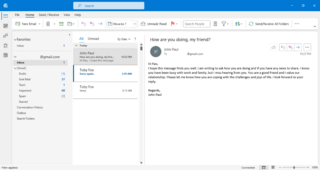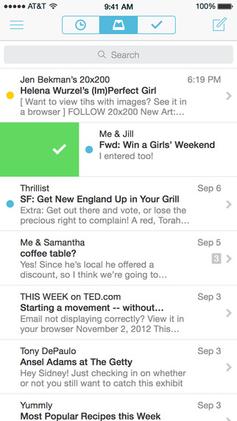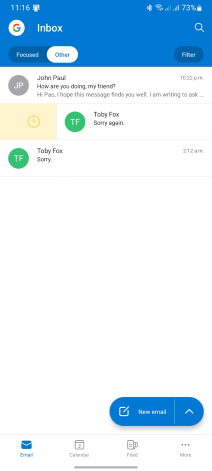
Microsoft Outlook is a personal information manager software system from Microsoft, available as a part of the Microsoft 365 software suites. Though primarily being popular as an email client for businesses, Outlook also includes functions such as calendaring, task managing, contact managing, note-taking, journal logging, web browsing, and RSS news aggregation.

Gmail is an email service provided by Google. As of 2019, it had 1.5 billion active users worldwide, making it the largest email service in the world. It also provides a webmail interface, accessible through a web browser, and is also accessible through the official mobile application. Google also supports the use of third-party email clients via the POP and IMAP protocols.

Google Calendar is a time-management and scheduling calendar service developed by Google. It was created by Mike Samuel as part of his 20% project at Google. It became available in beta release April 13, 2006, and in general release in July 2009, on the web and as mobile apps for the Android and iOS platforms.
Google Workspace is a collection of cloud computing, productivity and collaboration tools, software and products developed and marketed by Google. It consists of Gmail, Contacts, Calendar, Meet and Chat for communication; Currents for employee engagement; Drive for storage; and the Google Docs Editors suite for content creation. An Admin Panel is provided for managing users and services. Depending on edition Google Workspace may also include the digital interactive whiteboard Jamboard and an option to purchase add-ons such as the telephony service Voice. The education edition adds a learning platform Google Classroom and today has the name Workspace for Education.

The Gmail interface makes Gmail unique amongst webmail systems for several reasons. Most evident to users are its search-oriented features and means of managing e-mail in a "conversation view" that is similar to an Internet forum.
Exchange ActiveSync is a proprietary protocol designed for the synchronization of email, contacts, calendar, tasks, and notes from a messaging server to a smartphone or other mobile devices. The protocol also provides mobile device management and policy controls. The protocol is based on XML. The mobile device communicates over HTTP or HTTPS.
Google Drive is a file storage and synchronization service developed by Google. Launched on April 24, 2012, Google Drive allows users to store files in the cloud, synchronize files across devices, and share files. In addition to a web interface, Google Drive offers apps with offline capabilities for Windows and macOS computers, and Android and iOS smartphones and tablets. Google Drive encompasses Google Docs, Google Sheets, and Google Slides, which are a part of the Google Docs Editors office suite that permits collaborative editing of documents, spreadsheets, presentations, drawings, forms, and more. Files created and edited through the Google Docs suite are saved in Google Drive.

Mailbox was a freeware email management application for iOS and Android, developed by Orchestra, Inc. It drew the attention of numerous technology blogs for its usability and innovative features, such as swipe-based email sorting, snoozing and filtering. Weeks before its launch, a pre-registration period resulted in a waiting list of over 380,000 reservations. Upon its iOS launch on 7 February 2013, Mailbox became the second-most-downloaded free app in the App Store that day.

Mailbird is a desktop email client for Microsoft Windows, compatible with Windows 7 and all later versions. As well as sending and receiving emails, Mailbird includes managing calendar events and contacts from different email providers, social media, task management, file share, and video-conferencing integrations. Mailbird is offered via paid subscription, but also includes a free version.
IQTELL was a productivity app that allowed users to manage email, tasks, projects, calendars, contacts, Evernotes and more in a single app. IQTELL was available as a web app, as well as an iOS and Android app. All user information was automatically synced between all devices. iOS and Android apps supported offline access. The app could be used to implement concepts and techniques described in the book Getting Things Done by David Allen.

Newton is an email management application for iOS, Android, MacOS, Windows and ChromeOS developed by CloudMagic, Inc. The application is known for its searching capabilities, cross-platform abilities and user interface. It has been referred to as an email client better than Gmail's native app. As from September 15, 2016, CloudMagic has been renamed to Newton Mail with premium services, adding a host of new features and functions.

The Microsoft Outlook mobile app is a mobile personal information manager (PIM) for Android and iOS devices.
Acompli is a discontinued mobile app that allowed for user interaction with email messages as well as management of multiple email accounts in one programme. In addition, the tool also organized one's calendar and shared files. This application provided for integration with cloud storage platforms such as Dropbox, OneDrive, and iCloud; it also carried support for Microsoft Exchange and Gmail. Acompli launched on 24 April 2014. The startup company, which had $7.3 million in funding, was led by CEO Javier Soltero, J.J. Zhuang (CTO) and Kevin Henrikson.

Google Docs is an online word processor included as part of the free, web-based Google Docs Editors suite offered by Google, which also includes Google Sheets, Google Slides, Google Drawings, Google Forms, Google Sites and Google Keep. Google Docs is accessible via an internet browser as a web-based application and is also available as a mobile app on Android and iOS and as a desktop application on Google's ChromeOS.

Google Photos is a photo sharing and storage service developed by Google. It was announced in May 2015 and spun off from Google+, the company's former social network.

Google Allo was an instant messaging mobile app by Google for the Android and iOS mobile operating systems, with a web client available in some web browsers. It closed on March 12, 2019.
Google Duo was a proprietary voice over IP (VoIP) and videotelephony service released in 2016 by Google and merged into its Google Meet product in 2022. It was available for Android, IOS and web browsers. It let users make and receive one-to-one and group audio and video calls with other Duo users in high definition, using end-to-end encryption by default. Duo could be used either with a phone number or a Google account, allowing users to call someone from their contact list.
Google Travel, formerly Google Trips, is a trip planner service developed by Google. It was originally launched as a mobile app on September 19, 2016, for Android and iOS, which was shut down on August 5, 2019. The service is now only available on the website.

Google Meet is a video communication service developed by Google. It is one of two apps that constitute the replacement for Google Hangouts, the other being Google Chat. It replaced the consumer-facing Google Duo on November 1, 2022, with the Duo mobile app being renamed Meet and the original Meet app set to be phased out.












